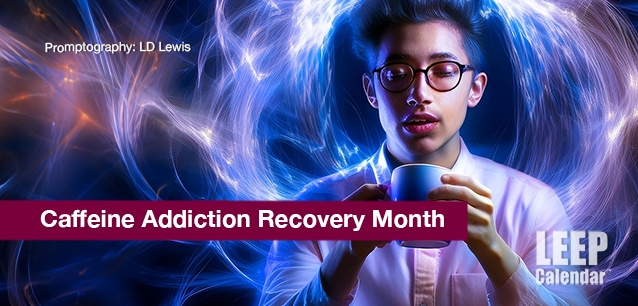 AD
AD
Today is: December 08
Scroll to explore events active on this date.
LEEP INK FEATURES

August? Absolutely!
In August, we live through the Dog Days of Summer. It's hot and often humid, and those who can leave for better climates do. Down south, winter is in full force. August is also known as "the ...

In The Heat of July: July 2025 Events
Is it hot enough (or cold enough if you're below the equator) for you yet? There is actually a day for that! Like every month, I pick a diverse collection of events you may or may not know about. This ...

May Blooms: Events in May 2025
Along with October, May is one of the most densely packed months of the year. It's before the summer humidity and the last whole month of the school year. The weather is warming in t...
About Caffeine Addiction Recovery Month
Health , United States
Ends: Oct 31, 2025
DESCRIPTION:
STAYING ENERGIZED NATURALLY:
CAFFEINE ADDICTION RECOVERY MONTH
October marks Caffeine Addiction Recovery Month, an initiative aimed at raising awareness about the potential risks of caffeine dependence and encouraging individuals to evaluate their caffeine consumption habits. This month-long observance seeks to educate the public on the effects of caffeine, promote healthier alternatives, and provide resources for those looking to reduce or eliminate their caffeine intake. Caffeine Addicts Anonymous created it. However, the group no longer exists, and the event is no longer sponsored. It is one of two caffeine-related months each year. The first is in March.
The word "caffeine" is derived from the German word "Kaffein," coined in the early 19th century. "Kaffein" refers to the compound found in coffee (German: "Kaffee") that produces stimulating effects. The term was later adapted into English as "caffeine," referring broadly to the stimulant in coffee, tea, and other beverages. The name reflects the connection between the compound and its most common natural source, coffee.
THE WORLD'S MOST POPULAR STIMULANT
Caffeine is a drug because it is a central nervous system stimulant that can alter brain function, leading to increased alertness and temporary boosts in energy. As a psychoactive substance, caffeine affects neurotransmitters in the brain, particularly adenosine, which regulates sleep. Regular consumption of caffeine can lead to physical dependence, and sudden withdrawal can cause symptoms such as headaches, irritability, and fatigue.
Some people have issues with caffeine while others do not, and the reason lies in genetic differences and individual tolerance levels. Factors such as metabolism, sensitivity to stimulants, and habitual consumption patterns all impact how a person responds to caffeine. For some, even small amounts can lead to anxiety, insomnia, or digestive issues, while others may consume larger quantities with minimal adverse effects.
MOST POPULAR SOURCES OF CAFFEINE
Caffeine is found in a variety of foods and drinks, with the top five sources being:
—Coffee
The most well-known source is coffee, which contains varying levels of caffeine depending on the type and preparation method.
—Tea
Black, green, and white teas all contain caffeine, though typically in lower amounts than coffee.
—Energy Drinks
These beverages are often high in caffeine and are designed to provide a quick energy boost.
—Soda
Many carbonated soft drinks, particularly colas, contain added caffeine.
—Chocolate
Both dark and milk chocolate contain small amounts of caffeine derived from cocoa beans.
Caffeine Addiction Recovery Month encourages people to be mindful of their caffeine intake and consider the potential long-term effects of overconsumption. For those struggling with dependence, the month provides an opportunity to seek support and make healthier lifestyle choices. By raising awareness, the initiative hopes to promote a balanced approach to caffeine use and highlight the importance of moderation.
VIDEOS
SUPPORTING DOCUMENTS
Currently, this event does not have supporting documents.
ADDITIONAL IMAGES
Currently, this event does not have supporting images.
Where would you like to go now?
 AD
AD


/footer-logo.svg)
